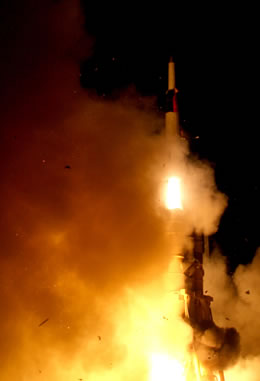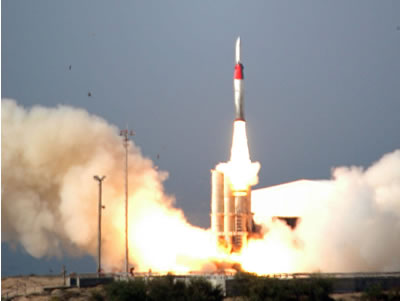Facing a growing threat of ballistic missiles and rockets capable of hitting any point in the country from distances of four, up to 2,000km, Israel has grouped its air defense forces into the ‘Air Defense Command’, integrating all active defense elements into an multi-layered defensive system. Israel’s missile defense wing currently maintains two principal assets, the ‘Sword Shield’ unit operating the IAI Arrow-2 ASIP (improved versions) since 1998, and the new ‘Iron Dome’ unit, equipped with three Rafael Counter-Rocket, Artillery & Missile (C-RAM) missile systems. The two systems were developed in Israel to meet specific requirements, peculiar to Israel at the time. The Arrow was designed to intercept Scud type medium range ballistic missiles, acquired by Iraq and Syria, while the Iron Dome was developed to defend from terrorist rocket attacks Israel has endured since 1968.

Arrow 2 is designed to intercept ballistic missiles at their terminal phase, as they re-enter the atmosphere. Unlike the modern air defense missiles, employing ‘hit to kill’ interceptors, Arrow 2 uses an advanced ‘aimable’ warhead to increase hit probability when passing the target at extremely high closing speed. Arrow 2 ASIP represents the latest evolution of the Arrow system, capable of intercepting faster targets, fired from longer ranges. The next step in its evolution is the Arrow 3 Exo-Atmospheric missile interceptor, currently in development. With thrust vectoring kill vehicle designed for hit-to-kill intercept, Arrow 3 will provide the ‘upper tier’ for the Israeli missile defense system, engaging hostile missiles in space, through their midcourse phase. The proliferation of ballistic missiles throughout Asia has triggered missile defense programs in the region, and the Israelis are hopeful that the newly expanded cooperation with the Boeing Company will open new opportunities for export of Arrow systems.
A most significant change will take place in 2013, as the new David’s Sling missile system, currently in final developmental testing at Rafael, will reach initial operational capability. Unlike the task specific Arrow 2 and Iron Dome, David’s Sling was developed as a flexible, multi-purpose weapon system capable of engaging aircraft, cruise missiles, ballistic and guided missiles as well as long range ballistic rockets. The missile is designed for land based, maritime and airborne applications. Providing a common missile known as ‘Stunner’, it is fitted with a dual seeker (IIR+RF) and a powerful multi-stage rocket motor enabling all weather operation and powerful kinematics including effective endgame maneuverability at extended ranges. David’s Sling will initially deploy with the IAF ‘Air Defense’ wing, replacing the Hawk missiles.
The system’s primary role will be to intercept medium and long-range ballistic and guided rockets, such as the Fajr-5 and M-600 (a Syrian copy of the Iranian Fateh-110), carrying half-ton warhead, these threats have a range of about 300 kilometers.
A different threat expected from the sea is the Russian supersonic Yakhont anti-ship missile recently delivered to Syria. This threat would be challenged by another air-defense system developed in Israel – IAI’s Barak 8. The missile, developed by IAI is designed to replace the existing Barak I point defense missile system deployed on the Israeli Saar V corvettes, providing extended ‘networked’ air defense protecting naval forces or offshore installations over a large area. Unlike the Arrow and David’s Sling, Barak-8 was developed without U.S. support, as it was designed primarily for the export market. Developed primarily as a naval air defense missile, Barak 8 is the cornerstone of the Indian Medium and Long Range Surface to Air Missile (MR-SAM/LR-SAM). The missile made the first flight test in 2010 and the entire system is scheduled to enter developmental testing in Israel and India in early 2012.
Iron Dome represents the world’s first combat proven C-RAM missile system. The IAF is planning to deploy a fourth Iron Dome battery in the coming months and is mulling the possibility of stationing it in Haifa Bay to protect Israel’s strategic industrial hub located there. The Defense Ministry has allocated a budget to manufacture three additional batteries by the end of 2012. IAF operational requirements call for the deployment of about a dozen batteries along Israel’s northern and southern borders. Future evolution of Iron Dome foresee the use of the system as a mobile asset, providing mobile land forces with protective C-RAM coverage, countering UAVs and defeating precision guided weapon attacks. Rafael is also evaluating a short-range complement for the current system, utilizing a guided projectile to be developed with the Italian group Oto-Melara.




















